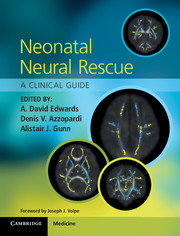Book contents
- Frontmatter
- Contents
- List of contributors
- Foreword
- Section 1 Scientific background
- Section 2 Clinical neural rescue
- 6 Challenges for parents and clinicians discussing neuroprotective treatments
- 7 The pharmacology of hypothermia
- 8 Selection of infants for hypothermic neural rescue
- 9 Hypothermia during patient transport
- 10 Whole body cooling for therapeutic hypothermia
- 11 Selective head cooling
- 12 Hypothermic neural rescue for neonatal encephalopathy in mid- and low-resource settings
- 13 Cerebral function monitoring and EEG
- 14 Magnetic resonance imaging in hypoxic–ischaemic encephalopathy and the effects of hypothermia
- 15 Novel uses of hypothermia
- 16 Neurological follow-up of infants treated with hypothermia
- 17 Registry surveillance after neuroprotective treatment
- Section 3 The future
- Index
- References
8 - Selection of infants for hypothermic neural rescue
from Section 2 - Clinical neural rescue
Published online by Cambridge University Press: 05 March 2013
- Frontmatter
- Contents
- List of contributors
- Foreword
- Section 1 Scientific background
- Section 2 Clinical neural rescue
- 6 Challenges for parents and clinicians discussing neuroprotective treatments
- 7 The pharmacology of hypothermia
- 8 Selection of infants for hypothermic neural rescue
- 9 Hypothermia during patient transport
- 10 Whole body cooling for therapeutic hypothermia
- 11 Selective head cooling
- 12 Hypothermic neural rescue for neonatal encephalopathy in mid- and low-resource settings
- 13 Cerebral function monitoring and EEG
- 14 Magnetic resonance imaging in hypoxic–ischaemic encephalopathy and the effects of hypothermia
- 15 Novel uses of hypothermia
- 16 Neurological follow-up of infants treated with hypothermia
- 17 Registry surveillance after neuroprotective treatment
- Section 3 The future
- Index
- References
Summary
Introduction
The overwhelming majority of term infants are born without labour and delivery complications and have a benign neonatal course with a favourable outcome. Those infants who do experience some transient interruption in placental blood flow are frequently able to adapt through several mechanisms which will be discussed later in this chapter, and also have a favourable outcome. The incidence of brain injury secondary to interruption of placental blood flow significant enough to result in intrapartum hypoxia–ischaemia is exceedingly uncommon with estimates that range from 1 to 2 per 1000 live term births in the developed world [1]. The ability to identify the high-risk infant in a timely manner is critical for several reasons. First, any novel intervention, including hypothermia, has the potential for significant side effects. Thus, targeting the appropriate population where the benefits outweigh the risks is critical. Second, for an intervention to be potentially neuroprotective it must be administered in a timely manner following a presumed insult, within the so-called “therapeutic window” to minimize or prevent ongoing reperfusion injury. Experimental data indicate that the therapeutic window is short at approximately 6 hours [2–5]. In this chapter, we shall review the perinatal indicators that have been shown to identify the high-risk infant who is likely to derive the most benefit from hypothermic neural rescue.
Pathophysiology
Severe and prolonged interruption of placental blood flow will ultimately lead to fetal asphyxia, characterized biochemically by progressive hypoxia, hypercarbia and acidosis [6]. Although the degree of acidemia with risk for brain injury may vary amongst infants, a cord umbilical arterial pH < 7.00 reflects a severity whereby the risk is increased [7,8]. Some obstetric complications which may be associated with asphyxia include fetal heart rate abnormalities ± meconium-stained amniotic fluid, placental abruption, uterine rupture and cord prolapse [9,10]. A major consequence of asphyxia is impaired cerebral blood flow (CBF), thought to be the causal mechanism for most of the neuropathology associated with hypoxic–ischaemic encephalopathy (HIE) [11]. Neuronal cell death occurs through two principal mechanisms comprised of necrosis and/or apoptosis. The pathway of cell death is in part determined by the intensity of the initial insult, with severe injury leading to necrosis and more mild injury resulting in apoptosis, although it is not uncommon to see histologic evidence of both processes [1,11].
- Type
- Chapter
- Information
- Neonatal Neural RescueA Clinical Guide, pp. 85 - 94Publisher: Cambridge University PressPrint publication year: 2013



